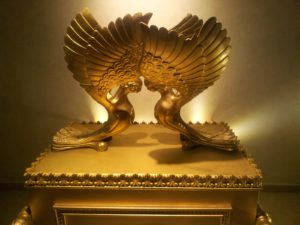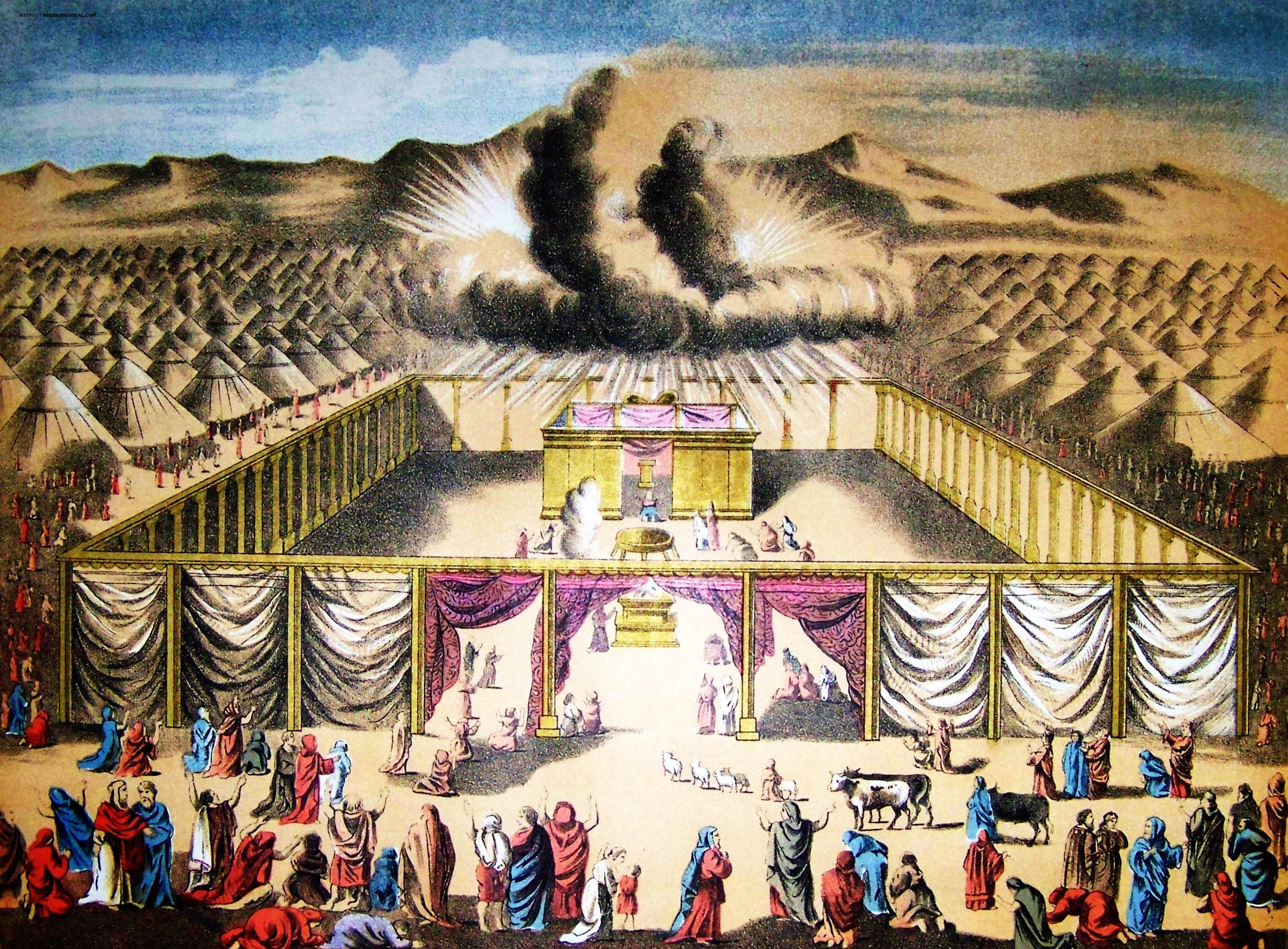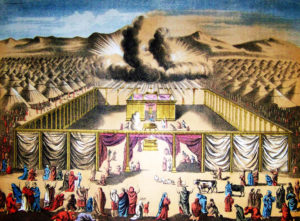Raboyseyee and Ladies
In previous postings and reviews on this very long -176 posik- parsha, which contains very disparate topics including the Nozir (Nazirite), the Soita (the married woman suspected by her husband of having an extramarital sexual affair), the counting of, and job assignments of the Livi’im, excommunication from the machaneh (encampment) of those with; leprosy, discharges and emissions, if you chap, and those that came into contact with a corpse (not just at home), if you chap. The parsha also introduces us to ‘birchas koihanim’ (the priestly blessings the kohanim are empowered to bestow upon the Yiddin), and a few other subjects. It’s a smorgasbord mamish. In previous postings on Nosi, we zicher more than adequately covered and uncovered the Soita (as did the Koihen) and described in detail the most unusual ceremony -for lack of a better word- to determine her guilt or innocence. We included many tantalizing graphical details of the entire procedure, the side effects of both innocence or guilt. We shall not repeat them here. Avada, many oisvorf followers will be interested to know, or freshen up, on the Soita just in case…ober, most will zicher be delighted to know that while thankfully the heylige Toirah remains very much alive, this particular truth seeking procedure is no longer in practice. Feel free to exhale and move about the cabin, if you chap. Avada that does not give any married woman license to find herself secluded with another man -chas v’sholom (heaven forbid)- and avada and avada, it does not give a heter (permission) for a man to be seducing a married woman. Why was the magical Soita water test halted? Due mamish to the exorbitant number of women suspected by their husbands of infidelity, and brought to the koihanim for testing. They were overwhelmed. Grada, a jealous husband who suspected and accused his eishes chayil of efsher cheating on him, was required to bring a korban (sacrifice) to the koihen (priest). Seemingly, this was his admission ticket into the Soita theater. Soita business was mamish booming; so brisk was business that the Koihanim were mistama getting quite fat eating all the korbonis brought by the jealous husbands.
If you are a new oisvorf follower, and taka the list of readers gets longer yearly, and avada longer is zicher preferred, if you chap, and, if you want more color -zicher you do- you can find it at www.oisvorfer.com. Check out the archives.
 Speaking of husbands suspecting their wives of infidelity, so happens that just a few days back, over the Yom Tov of Shovuis, the yurtzeit of Dovid Hamelech (King David), the Oisvorfer got into a rather heated argument and more, with a gentleman (loosely used) he met mamish but days earlier. Very loud words were exchanged and the insults were flying. What could two yiddin be arguing over? Over the behavior of Dovid Hamelech (King David) and Batsheva, who was zicher married at the time of their encounter. More on that and more on Dovid and Batsheva in an upcoming special edition.
Speaking of husbands suspecting their wives of infidelity, so happens that just a few days back, over the Yom Tov of Shovuis, the yurtzeit of Dovid Hamelech (King David), the Oisvorfer got into a rather heated argument and more, with a gentleman (loosely used) he met mamish but days earlier. Very loud words were exchanged and the insults were flying. What could two yiddin be arguing over? Over the behavior of Dovid Hamelech (King David) and Batsheva, who was zicher married at the time of their encounter. More on that and more on Dovid and Batsheva in an upcoming special edition.
Over the past six years, we have on more than one occasion, discussed repetition in the heylige Toirah. Of all the parshas in the heylige Toirah, it’s davka this parsha of Nosi, which we will have the pleasure of hearing this coming shabbis, where one will find a plethora of such repetition. How much? A lot! And If ever there was a parsha that requires some explanation on why certain pisukim are repeated over and again -twelve different times to be exact- it’s Nosi. We need not spend much time on the text because for the most part, the words are rather self-explanatory. Instead we need to better chap what our sages taught us about this parsha and the heylige Toirah in general. And what they taught us was this: the heylige Toirah contains not one extra word, letter or even a crown above a letter. In other words: if the words appear in the heylige Toirah, if the RBSO decided to include them, there is a good reason. What that reason is, ver veyst? Who says you have to know, or that the RBSO owes it to you to further explain? He’s the boss! That didn’t however over the generations, preclude our sages and countless other commentators from proffering different thoughts on each such repetition. As expected, many were zicher left scratching their heads when they arrived to Nosi because a total of 72 pisukim out of 176 or just over 40% could have been eliminated. We got the point: each Nosi (chieftain or tribal leader) brought korbonis (sacrifices ) in honor of the Mishkan’s inauguration. In those 72 pisukim, the heylige Toirah delineates painstakingly the details of each Nosee’s offering and what each and every Nosee brought. Who presented first and what did the gift offering consist of? Let’s quickly review the list of gifts brought by Nachshoin Ben Aminodov, he the Nosse of sheyvet Yehudah and he, also the brave person who (according to the medrish, was the first to jump into the Yam Suf (sea of reeds) which finally split when the waters were up to his neck. Another medrish will tell us that Nachshoin was the first to present his korban and other gifts davka because of his bravery.
| 11. The Lord said to Moses: One chieftain each day, one chieftain each day, shall present his offering for the dedication of the altar. | יאוַיֹּאמֶר יְהוָֹה אֶל משֶׁה נָשִׂיא אֶחָד לַיּוֹם נָשִׂיא אֶחָד לַיּוֹם יַקְרִיבוּ אֶת קָרְבָּנָם לַחֲנֻכַּת הַמִּזְבֵּחַ: | |
| 12. The one who brought his offering on the first day was Nahshon the son of Amminadab of the tribe of Judah. | יבוַיְהִי הַמַּקְרִיב בַּיּוֹם הָרִאשׁוֹן אֶת קָרְבָּנוֹ נַחְשׁוֹן בֶּן עַמִּינָדָב לְמַטֵּה יְהוּדָה: | |
| 13. And his offering was one silver bowl weighing one hundred and thirty [shekels], one silver sprinkling basin [weighing] seventy shekels according to the holy shekel, both filled with fine flour mixed with olive oil for a meal offering. | יגוְקָרְבָּנוֹ קַעֲרַת כֶּסֶף אַחַת שְׁלשִׁים וּמֵאָה מִשְׁקָלָהּ מִזְרָק אֶחָד כֶּסֶף שִׁבְעִים שֶׁקֶל בְּשֶׁקֶל הַקֹּדֶשׁ שְׁנֵיהֶם | מְלֵאִים סֹלֶת בְּלוּלָה בַשֶּׁמֶן לְמִנְחָה: | |
| 14. One spoon [weighing] ten [shekels] of gold filled with incense. | ידכַּף אַחַת עֲשָׂרָה זָהָב מְלֵאָה קְטֹרֶת: | |
| 15. One young bull, one ram and one lamb in its first year for a burnt offering. | טופַּר אֶחָד בֶּן בָּקָר אַיִל אֶחָד כֶּבֶשׂ אֶחָד בֶּן שְׁנָתוֹ לְעֹלָה: | |
| 16. One young he goat for a sin offering. | טזשְׂעִיר עִזִּים אֶחָד לְחַטָּאת: | |
| 17. And for the peace offering: two oxen, five rams, five he goats, five lambs in their first year; this was the offering of Nahshon the son of Amminadab. | יזוּלְזֶבַח הַשְּׁלָמִים בָּקָר שְׁנַיִם אֵילִם חֲמִשָּׁה עַתּוּדִים חֲמִשָּׁה כְּבָשִׂים בְּנֵי שָׁנָה חֲמִשָּׁה זֶה קָרְבַּן נַחְשׁוֹן בֶּן עַמִּינָדָב: |
And without repeating them, let’s agree that each and every Nosee brought the same exact gift to the Mishkan project. Mamish 12 different Nisiim brought mamish the same assortment of gifts? Taka so! And was this a coincidence? Was this what the RBSO had ordered? And if they were mamish the same, why was each Nosee’s gift repeated? The heylige Toirah could have told us what Nosse #1 brought and then told us that each Nosse brought the very same. Alternatively, the heylige Toirah could have described the korbonis and then told us that each Nosee brought the same. Grada, the heylige Toirah does just that: it provides the summary of the gifts in the 4 pisukim below (Bamidbar 7:84-88). Let’s read them.
| 84. This was the dedication offering of the altar presented by the chieftains on the day it was anointed; there were twelve silver bowls, twelve silver basins and twelve gold spoons. | פדזֹאת | חֲנֻכַּת הַמִּזְבֵּחַ בְּיוֹם הִמָּשַׁח אֹתוֹ מֵאֵת נְשִׂיאֵי יִשְׂרָאֵל קַעֲרֹת כֶּסֶף שְׁתֵּים עֶשְׂרֵה מִזְרְקֵי כֶסֶף שְׁנֵים עָשָׂר כַּפּוֹת זָהָב שְׁתֵּים עֶשְׂרֵה: | |
| 85. The weight of each silver bowl was one hundred and thirty [shekels], and that of each basin was seventy [shekels]; all the silver of the vessels weighed in total two thousand four hundred [shekels] according to the holy shekel. | פהשְׁלשִׁים וּמֵאָה הַקְּעָרָה הָאַחַת כֶּסֶף וְשִׁבְעִים הַמִּזְרָק הָאֶחָד כֹּל כֶּסֶף הַכֵּלִים אַלְפַּיִם וְאַרְבַּע מֵאוֹת בְּשֶׁקֶל הַקֹּדֶשׁ: | |
| 86. Twelve gold spoons filled with incense; each spoon weighing ten [shekels] according to the holy shekel; all the gold spoons totaled one hundred and twenty shekels. | פוכַּפּוֹת זָהָב שְׁתֵּים עֶשְׂרֵה מְלֵאֹת קְטֹרֶת עֲשָׂרָה עֲשָׂרָה הַכַּף בְּשֶׁקֶל הַקֹּדֶשׁ כָּל זְהַב הַכַּפּוֹת עֶשְׂרִים וּמֵאָה: | |
| 87. The total of the cattle for the burnt offerings was twelve bulls, twelve rams, and twelve lambs in their first year with their meal offerings. And [there were] twelve young he goats for sin offerings. | פזכָּל הַבָּקָר לָעֹלָה שְׁנֵים עָשָׂר פָּרִים אֵילִם שְׁנֵים עָשָׂר כְּבָשִׂים בְּנֵי שָׁנָה שְׁנֵים עָשָׂר וּמִנְחָתָם וּשְׂעִירֵי עִזִּים שְׁנֵים עָשָׂר לְחַטָּאת: | |
| 88. The total of cattle for the peace offerings was twenty four oxen, sixty rams, sixty he goats, and sixty lambs in their first year. This was the dedication offering for the altar, after it was anointed. | פחוְכֹל בְּקַר | זֶבַח הַשְּׁלָמִים עֶשְׂרִים וְאַרְבָּעָה פָּרִים אֵילִם שִׁשִּׁים עַתֻּדִים שִׁשִּׁים כְּבָשִׂים בְּנֵי שָׁנָה שִׁשִּׁים זֹאת חֲנֻכַּת הַמִּזְבֵּחַ אַחֲרֵי הִמָּשַׁח אֹתוֹ: |
Shtelt zich di shaylo (the question arises) azoy: why taka does the Toirah repeat them? Though we avada accept what our holy sages taught us about the heylige Toirah not having any extra words or letters, whenever such repetition is found, our sages and many other commentators needed to scramble to try and chap why taka the RBSO decided to repeat what might at first glance seem like glaring repletion for no reason.
 Nu, the first place to look for answers for any parsha related question is avada Rashi. Why Rashi? Because he either knew all the answers or figured them out. Ober after reading Rashi, the Oisvorfer was still confused. Why so? Because Rashi comments only on the rationale of the korban and gifts brought by Nesanale ben Tzoar. So happens that Nesanale ben Tzoar’s offering was brought only after Nachshoin Ben Aminodov. He was second in the lineup. As to the offerings of the other Nisi’im, Rashi remains silent. Ober says the Chofetz Chaim so gishmak, azoy: Nesanale ben Tzoar’s motivation in bringing the very same offering as did Nachshoin ben Aminodov was not to imitate or copy. Farkert: he, like the others, put much thought into his offering. So happens that each Nosee, after contemplating what to bring, decided to bring the very same offering. Taka amazing and admittedly most unusual. Couldn’t they show some originality and mix it up a bit? What taka motivated them, after much thought and contemplation to copy one another, was their great desire to show achdus (unity) and for sholom (peace) among themselves. Seemingly they wanted to avoid jealousies that could arise when more than one person brings a korban. Efsher they recalled what took place way back in Bereishis when two brothers, Kayin and Hevel, each brought a unique offering to the RBSO. Avada you recall learning that one was accepted by the RBSO while one was rejected. Sadly, that did not work out too well. What happened next? Shoin: one brother killed the other in fit of jealousy.
Nu, the first place to look for answers for any parsha related question is avada Rashi. Why Rashi? Because he either knew all the answers or figured them out. Ober after reading Rashi, the Oisvorfer was still confused. Why so? Because Rashi comments only on the rationale of the korban and gifts brought by Nesanale ben Tzoar. So happens that Nesanale ben Tzoar’s offering was brought only after Nachshoin Ben Aminodov. He was second in the lineup. As to the offerings of the other Nisi’im, Rashi remains silent. Ober says the Chofetz Chaim so gishmak, azoy: Nesanale ben Tzoar’s motivation in bringing the very same offering as did Nachshoin ben Aminodov was not to imitate or copy. Farkert: he, like the others, put much thought into his offering. So happens that each Nosee, after contemplating what to bring, decided to bring the very same offering. Taka amazing and admittedly most unusual. Couldn’t they show some originality and mix it up a bit? What taka motivated them, after much thought and contemplation to copy one another, was their great desire to show achdus (unity) and for sholom (peace) among themselves. Seemingly they wanted to avoid jealousies that could arise when more than one person brings a korban. Efsher they recalled what took place way back in Bereishis when two brothers, Kayin and Hevel, each brought a unique offering to the RBSO. Avada you recall learning that one was accepted by the RBSO while one was rejected. Sadly, that did not work out too well. What happened next? Shoin: one brother killed the other in fit of jealousy.
Efsher we can kler azoy (Oisvorfer pshat): Perhaps, the Nisi’im did meet and did collude and then decided that it was better to imitate and live, rather than show originality and efsher put their lives in danger. And so impressed was the RBSO by this show of unity, such unity having been seen only once before in Jewish history when the Yiddin, as we read mamish on the Yom Tov of Shovuis, rested as one unit under Har Sinai as they prepared to marry the RBSO and accept the heylige Toirah, He decided to delineate every single korban. No Nosee wanted to upstage the other and show off his offering. So happens that such occurrences, when the Yiddin act as one unit, with peace in mind, take place very rarely.
 Efsher peace and unity were on their minds davka because the Nisi’im needed a second chance to redeem themselves. Avada we all recall that the Nisi’im were the last to donate to the building of the Mishkan and were taken to task for their tardiness. Ober when it came to its inauguration, they, after conferring, banded together in a show of achdus and unity and decided as a group that each would bring the same offering. Perhaps their show of achdus and brotherhood was their second chance to show true leadership. This pshat would also fit for the suspected Soitah. Were she to successfully pass the magic water test meaning she was mamish innocent of the charges, she would be the beneficiary of a second chance (at her marriage) and then several other blessings.
Efsher peace and unity were on their minds davka because the Nisi’im needed a second chance to redeem themselves. Avada we all recall that the Nisi’im were the last to donate to the building of the Mishkan and were taken to task for their tardiness. Ober when it came to its inauguration, they, after conferring, banded together in a show of achdus and unity and decided as a group that each would bring the same offering. Perhaps their show of achdus and brotherhood was their second chance to show true leadership. This pshat would also fit for the suspected Soitah. Were she to successfully pass the magic water test meaning she was mamish innocent of the charges, she would be the beneficiary of a second chance (at her marriage) and then several other blessings.
Interestingly enough, we read the 72 pisukim long description of the offerings only after the birchas koihanim which ends with the words ‘Viyosame licho sholom (and the RBSO should bestow upon you peace). Peace and unity seem are efsher the themes of the parsha.
Shoin, now that we chap or think we do, why the RBSO decided to repeat the details of every single Nosee gift, let’s look at these three pisukim which precede the lengthy presentation. Says the heylige Toirah (Bamidbar 7:3) azoy: “They brought their offering before the Lord: six covered wagons and twelve oxen- a wagon for each two chieftains, and an ox for each one; they presented them in front of the Mishkan”. Ober wait: Weren’t there 12 Nisiim? And didn’t each one bring the same exact gift? Yes and yes? How then did it come about that among the 12 of them, that only 6 wagons were donated or used to transport the gifts over to the Mishkan? Which one’s brought wagons and which didn’t? And the answer is we don’t know and we don’t know because the heylige Toirah doesn’t tell us. Shoin: seemingly, generations before ride sharing for economical reasons, or, to gain access to HOV lanes became popular, or even known, along came the Nisi’im who introduced this concept when but a total of six wagons were used to transport the twelve Nisi’im and their offerings.
 And says the Oznayim Latoirah so gishmak azoy: the six wagons represented achdus (unity), perhaps even more so than the oxen, for the wagons were seemingly purchased in partnership as the contribution of two leaders, whereas each leader needed purchase his own ox. Exactly who in the midbar had an authorized wagon dealership, ver veyst. Only individuals at peace with themselves have the ability to be at peace with others and to work closely to achieve the stated goal. That goal was to enhance the inauguration of the Mishkan which they did. The RBSO was impressed and decided to dedicate 72 verses in His heylige Toirah so that each Nosee got his due. The Nisi’im achieved such peace, hence they were properly positioned to work as a unit.
And says the Oznayim Latoirah so gishmak azoy: the six wagons represented achdus (unity), perhaps even more so than the oxen, for the wagons were seemingly purchased in partnership as the contribution of two leaders, whereas each leader needed purchase his own ox. Exactly who in the midbar had an authorized wagon dealership, ver veyst. Only individuals at peace with themselves have the ability to be at peace with others and to work closely to achieve the stated goal. That goal was to enhance the inauguration of the Mishkan which they did. The RBSO was impressed and decided to dedicate 72 verses in His heylige Toirah so that each Nosee got his due. The Nisi’im achieved such peace, hence they were properly positioned to work as a unit.
A gittin Shabbis
The Oisvorfer Ruv
Yitz Grossman

